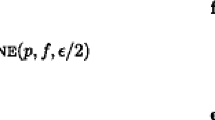Abstract
To ensure uninterrupted service, telecommunication networks contain excess (spare) capacity for rerouting (restoring) traffic in the event of a link failure. We study the NP-hard capacity planning problem of economically installing spare capacity on a network to permit link restoration of steady-state traffic. We present a planning model that incorporates multiple facility types, and develop optimization-based heuristic solution methods based on solving a linear programming relaxation and minimum cost network flow subproblems. We establish bounds on the performance of the algorithms, and discuss problem instances that nearly achieve these worst-case bounds. In tests on three real-world problems and numerous randomly-generated problems containing up to 50 nodes and 150 edges, the heuristics provide good solutions (often within 0.5% of optimality) to problems with single facility type, in equivalent or less time than methods from the literature. For multi-facility problems, the gap between our heuristic solution values and the linear programming bounds are larger. However, for small graphs, we show that the optimal linear programming value does not provide a tight bound on the optimal integer value, and our heuristic solutions are closer to optimality than implied by the gaps.
Similar content being viewed by others
References
R. Ahuja, T.L. Magnanti and J. Orlin, Network Flows: Theory, Algorithms, and Applications (Prentice–Hall, Englewood Cliffs, NJ, 1993).
A. Balakrishnan, T.L. Magnanti and P. Mirchandani, A dual–based algorithm for multi–level network design, Management Science 40 (1994) 567–581.
A. Balakrishnan, T.L. Magnanti, J.S. Sokol and Y. Wang, Spare capacity assignment for line restoration using a single facility type, Operations Research (2001) (to appear).
D. Bienstock and G. Muratore, Strong inequalities for capacitated survivable network design problems, Working paper, Columbia University, New York, NY (1997).
T. Chujo, H. Komine, K. Miyazaki, T. Ogura and T. Soejima, Distributed self–healing network and its optimum spare–capacity assignment algorithm, Electronics and Communications in Japan, Part 1 74 (1991) 1–9.
G. Dahl and M. Stoer, A cutting plane algorithm for multicommodity survivable network design problems, INFORMS Journal on Computing 10 (1998) 1–11.
D.A. Dunn, W.D. Grover and M.H. MacGregor, Comparison of k–shortest paths and maximum flow routing for network facility restoration, IEEE JSAC 12 (1994) 88–99.
F. Fahim and J.C. Shah, Private correspondence (September 1994–May 1995).
V. Garcia and P. Ritchi, Private conversation (Fall 1996).
M. Groetschel, C. Monma and M. Stoer, Design of survivable networks, in: Network Models, eds. M.O. Ball, T.L. Magnanti, C.L. Monma and G.L. Nemhauser, Handbooks in Operations Research and Management Science, Vol. 7 (North–Holland, Amsterdam, 1995) pp. 617–672.
W.D. Grover, T.D. Bilodeau and B.D. Venables, Near optimal spare capacity planning in a mesh restorable network, in: IEEE Global Telecommunications Conference (1991) pp. 2007–2012.
M. Herzberg, A decomposition approach to assign spare channels in self–healing networks, in: IEEE Global Telecommunications Conference (1993) pp. 1601–1605.
M. Herzberg, S.J. Bye and A. Utano, The hop–limit approach for spare capacity assignment in survivable networks, IEEE/ACM Transactions on Networking 3 (1995) 775–784.
M. Iri, How to generate realistic sample problems for network optimization, in: Lecture Notes in Computer Science 650 (1992) 342–350.
J. Kennington and J.E. Whitler, An efficient decomposition algorithm to optimize spare capacity in a telecommunications network, INFORMS Journal on Computing 11 (1999) 149–160.
L. Lee and H.W. Chun, An ANN approach to spare capacity planning, in: IEEE Region 10 International Conference (1992) pp. 891–895.
Y. Lee, Computation analysis of network optimization algorithms, Ph.D. thesis, Massachusetts Institute of Technology, Cambridge, MA (1993).
P.A.W. Lewis, A.S. Goodman and J.M. Miller, A pseudo–random number generator for the system 360, IBM System Journal 8 (1969) 136–146.
A. Lisser, R. Sarkissian and J. Vial, Survivability in transmission telecommunication networks, Technical report 1995.3, CNET, Paris, France (1995).
A. Lisser, R. Sarkissian and J. Vial, Optimal joint syntheses of base and spare telecommunication networks, in: International Symposium on Mathematical Programming (1997).
T.L. Magnanti, P. Mirchandani and R. Vachani, Modeling and solving the two–facility capacitated network loading problem, Operations Research 43 (1995) 142–157.
T.L. Magnanti and Y. Wang, Polyhedral properties of the network restoration problem–with the convex hull of a special case, Working paper OR 323–97, Operations Research Center, Massachusetts Institute of Technology, Cambridge, MA (1997).
T.L. Magnanti and L. Wolsey, Optimal trees, in: Network Models, eds. M.O. Ball, T.L. Magnanti, C.L. Monma and G.L. Nemhauser, Handbooks in Operations Research and Management Science, Vol. 7 (North–Holland, Amsterdam) pp. 503–616.
K.A. Meshkovskiy and A.Y. Rokotyan, Restoration of communications network connectivity following the failure of transmission junctions and lines, Telecommunications and Radio Engineering 47 (1992) 1–5.
M. Minoux, Network synthesis and optimum network design problems, Networks 19 (1989) 313–360.
H. Sakauchi, Y. Nichimura and S. Hasegawa, A self–healing network with an economical spare channel assignment, in: IEEE Global Telecommunications Conference (1990) pp. 438–443.
M. Stoer and G. Dahl, A polyhedral approach to multicommodity survivable network design, Numerische Mathematik 68 (1994) 149–167.
R. Vachani and P. Kubat, Design of survivable telecommunications networks: Models and algorithms, in: ORSA/TIMS Joint National Conference, Phoenix, AZ (1994).
J. Veerasamy, S. Venkatesan and J.C. Shah, Effect of traffic splitting on link and path restoration planning, in: IEEE Global Telecommunications Conference (1994) pp. 1867–1871.
J. Veerasamy, S. Venkatesan and J.C. Shah, Spare capacity assignment in telecom networks using path restoration, in: MASCOTS 1995 (1995) pp. 370–375.
B.D. Venables, Algorithms for the spare capacity design of mesh restorable networks, M. Sci. thesis, University of Alberta, Edmonton, Alberta, Canada (1992).
B.D. Venables, W.D. Grover and M.H. MacGregor, Two strategies for spare capacity placement in mesh restorable networks, in: IEEE International Conference on Communications (1993) pp. 267–271.
C. Yang and S. Hasegawa, FITNESS: Failure immunization technology for network service survivability, in: IEEE Global Telecommunications Conference (1988) pp. 1549–1554.
Author information
Authors and Affiliations
Rights and permissions
About this article
Cite this article
Balakrishnan, A., Magnanti, T.L., Sokol, J.S. et al. Telecommunication Link Restoration Planning with Multiple Facility Types. Annals of Operations Research 106, 127–154 (2001). https://doi.org/10.1023/A:1014509708610
Issue Date:
DOI: https://doi.org/10.1023/A:1014509708610




